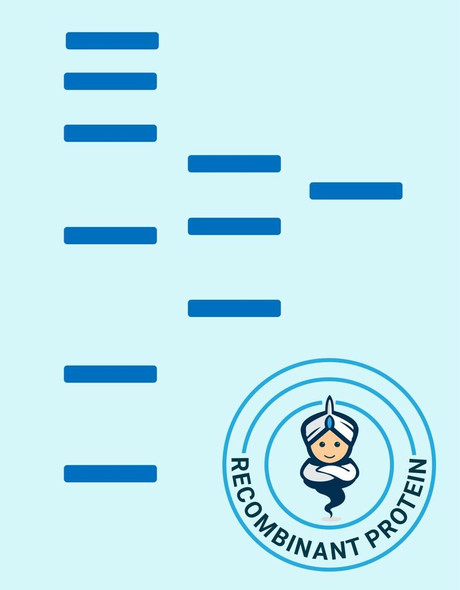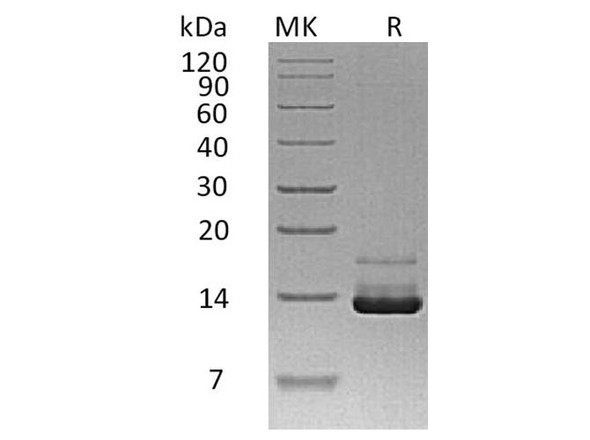Description
| Product Name: | Human PTH (7-34) Recombinant Protein |
| Product Code: | RPPB1301 |
| Size: | 0.5mg |
| Species: | Human |
| Target: | PTH (7-34) |
| Synonyms: | PTH/PTHrP receptor antagonist, PTHrP analog, PTHR, MGC138426, MGC138452. |
| Source: | Escherichia Coli |
| Physical Appearance: | Sterile Filtered White lyophilized (freeze-dried) powder. |
| Formulation: | The protein (1 mg/ml) was lyophilized after extensive dialyses against 20mM PBS pH-7.0 and 150mM NaCl. |
| Solubility: | It is recommended to reconstitute the lyophilized PTH in sterile 18M?-cm H2O not less than 100 �g/ml, which can then be further diluted to other aqueous solutions. |
| Stability: | Lyophilized Parathyrin although stable at room temperature for 3 weeks, should be stored desiccated below -18°C. Upon reconstitution PTH should be stored at 4°C between 2-7 days and for future use below -18°C.For long term storage it is recommended to add a carrier protein (0.1% HSA or BSA).Please prevent freeze-thaw cycles. |
| Purity: | Greater than 97.0% as determined by:(a) Analysis by RP-HPLC.(b) Analysis by SDS-PAGE. |
| Amino Acid Sequence: | LMHNLGKHLN SMERVEWLRK KLQDVHNF |
| Biological Activity: | The activity calculated by UMR106 cell/cAMP method corresponding to a specific activity of 10,000 Units/mg. |
Polypeptide hormones secreted by the parathyroid glands, which promote release of calcium from bone to extracellular fluid by activating osteoblasts and inhibiting osteoclasts, indirectly promote increased intestinal absorption of calcium, and promote renal tubular reabsorption of calcium and increased renal excretion of phosphates. It is a major regulator of bone metabolism. Secretion of parathyroid hormone increases when the level of calcium in the extracellular fluid is low. Its action is opposed by calcitonin. PTH (7-34), which is a PTH/PTHrP receptor antagonist, can stimulate hair growth and epidermal proliferation in mice.
Parathyroid Hormone Human Recombinant produced in E.Coli is a single, non-glycosylated, polypeptide chain containing 28 amino acids and having a molecular mass of 3380 Dalton. The PTH is purified by proprietary chromatographic techniques.
| UniProt Protein Function: | PTHR: This is a receptor for parathyroid hormone and for parathyroid hormone-related peptide. The activity of this receptor is mediated by G proteins which activate adenylyl cyclase and also a phosphatidylinositol-calcium second messenger system. Defects in PTH1R are the cause of Jansen metaphyseal chondrodysplasia (JMC). JMC is a rare autosomal dominant disorder characterized by a short-limbed dwarfism associated with hypercalcemia and normal or low serum concentrations of the two parathyroid hormones. Defects in PTH1R are the cause of chondrodysplasia Blomstrand type (BOCD). BOCD is a severe skeletal dysplasia. Defects in PTH1R may be a cause of enchondromatosis multiple (ENCHOM). Enchondromas are common benign cartilage tumors of bone. They can occur as solitary lesions or as multiple lesions in enchondromatosis (Ollier and Maffucci diseases). Clinical problems caused by enchondromas include skeletal deformity and the potential for malignant change to osteosarcoma. Defects in PTH1R are the cause of Eiken skeletal dysplasia (EISD); also known as bone modeling defect of hands and feet. It is a rare familial autosomal recessive skeletal dysplasia. It is characterized by multiple epiphyseal dysplasia, with extremely retarded ossification, principally of the epiphyses, pelvis, hands and feet, as well as by abnormal modeling of the bones in hands and feet, abnormal persistence of cartilage in the pelvis and mild growth retardation. Defects in PTH1R are a cause of primary failure of tooth eruption (PFE). PFE is a rare condition that has high penetrance and variable expressivity and in which tooth retention occurs without evidence of any obvious mechanical interference. Instead, malfunction of the eruptive mechanism itself appears to cause nonankylosed permanent teeth to fail to erupt, although the eruption pathway has been cleared by bone resorption. Belongs to the G-protein coupled receptor 2 family. |
| UniProt Protein Details: | Protein type:GPCR, family 2; Membrane protein, multi-pass; Membrane protein, integral; Receptor, GPCR Chromosomal Location of Human Ortholog: 3p22-p21.1 Cellular Component: basolateral plasma membrane; integral to plasma membrane; brush border membrane; apical plasma membrane; cytoplasm; plasma membrane; nucleus; receptor complex Molecular Function:protein binding; protein self-association; peptide hormone binding; parathyroid hormone receptor activity Biological Process: cell maturation; G-protein signaling, adenylate cyclase activating pathway; bone mineralization; osteoblast development; G-protein signaling, coupled to cAMP nucleotide second messenger; G-protein coupled receptor protein signaling pathway; G-protein signaling, coupled to cyclic nucleotide second messenger; negative regulation of cell proliferation; elevation of cytosolic calcium ion concentration; positive regulation of cell proliferation; chondrocyte differentiation; G-protein signaling, coupled to IP3 second messenger (phospholipase C activating); skeletal development; bone resorption; aging Disease: Eiken Syndrome; Chondrodysplasia, Blomstrand Type; Failure Of Tooth Eruption, Primary; Metaphyseal Chondrodysplasia, Jansen Type |
| NCBI Summary: | The protein encoded by this gene is a member of the G-protein coupled receptor family 2. This protein is a receptor for parathyroid hormone (PTH) and for parathyroid hormone-like hormone (PTHLH). The activity of this receptor is mediated by G proteins which activate adenylyl cyclase and also a phosphatidylinositol-calcium second messenger system. Defects in this receptor are known to be the cause of Jansen's metaphyseal chondrodysplasia (JMC), chondrodysplasia Blomstrand type (BOCD), as well as enchodromatosis. Two transcript variants encoding the same protein have been found for this gene. [provided by RefSeq, May 2010] |
| UniProt Code: | Q03431 |
| NCBI GenInfo Identifier: | 417555 |
| NCBI Gene ID: | 5745 |
| NCBI Accession: | Q03431.1 |
| UniProt Secondary Accession: | Q03431,Q2M1U3, |
| UniProt Related Accession: | Q03431 |
| Molecular Weight: | 66,361 Da |
| NCBI Full Name: | Parathyroid hormone/parathyroid hormone-related peptide receptor |
| NCBI Synonym Full Names: | parathyroid hormone 1 receptor |
| NCBI Official Symbol: | PTH1R�� |
| NCBI Official Synonym Symbols: | PFE; PTHR; PTHR1�� |
| NCBI Protein Information: | parathyroid hormone/parathyroid hormone-related peptide receptor; PTH1 receptor; PTH/PTHr receptor; PTH/PTHrP type I receptor; parathyroid hormone receptor 1; seven transmembrane helix receptor; parathyroid hormone/parathyroid hormone-related protein receptor |
| UniProt Protein Name: | Parathyroid hormone/parathyroid hormone-related peptide receptor |
| UniProt Synonym Protein Names: | PTH/PTHrP type I receptor; PTH/PTHr receptor; Parathyroid hormone 1 receptor; PTH1 receptor |
| Protein Family: | Parathyroid hormone/parathyroid hormone-related peptide receptor |
| UniProt Gene Name: | PTH1R�� |
| UniProt Entry Name: | PTH1R_HUMAN |










